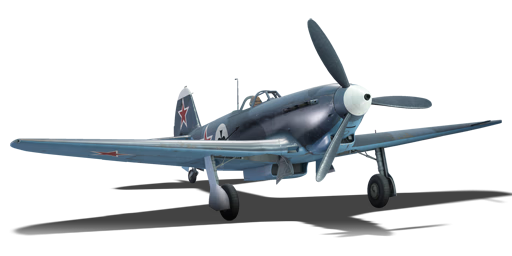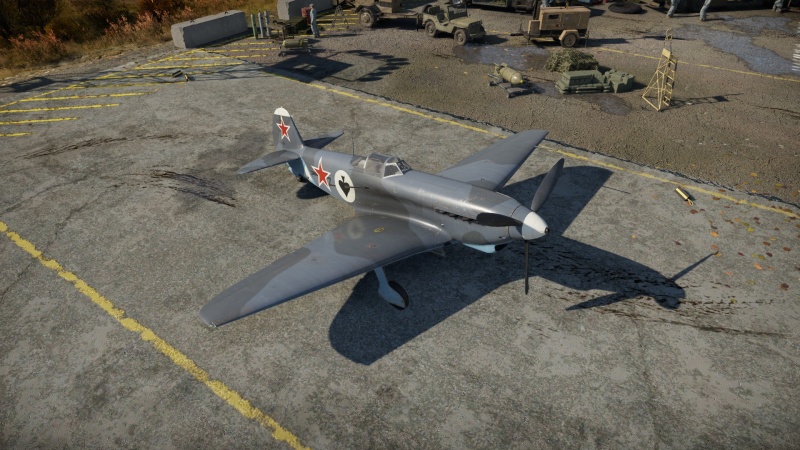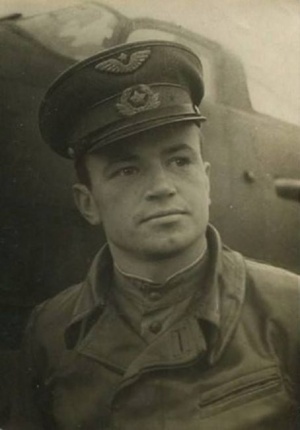Difference between revisions of "Golovachev's Yak-9M"
Colok76286 (talk | contribs) (Edits) |
Colok76286 (talk | contribs) (Edits) |
||
| Line 119: | Line 119: | ||
==== Naval Battle ==== | ==== Naval Battle ==== | ||
| − | In a naval battles, the Yak-9M armament is enough to reap havoc upon the enemy patrol ships. The important factour is not to come in straight by instead climb and dive upon them like Zeus throwing a lighting bolt into the ground, when that bolt hits the ground it explodes! Make sure to lead the enemy ship and aim for the bridge, a few shots here with | + | In a naval battles, the Yak-9M armament is enough to reap havoc upon the enemy patrol ships. The important factour is not to come in straight by instead climb and dive upon them like Zeus throwing a lighting bolt into the ground, when that bolt hits the ground it explodes! Make sure to lead the enemy ship and aim for the bridge, a few shots here with its 20 mm shVAK will sink the ship, if not cause major damage and knockout most of its crew. |
Revision as of 11:46, 17 March 2022
| This page is about the premium gift Soviet fighter Golovachev's Yak-9M. For other versions, see Yak-9 (Family). |
Contents
Description
Golovachev's Yak-9M is a premium gift rank III Soviet fighter with a battle rating of 3.7 (AB/RB/SB). It was introduced as a premium pack in Update 1.49 "Weapons of Victory" and was removed from the Gaijin store in May 2016. It has since been brought back on occasion, such as the 2017 "Special Discounts!" and the 2021 May sales.
The plane is painted after the camouflage scheme of Soviet pilot Pavel Y. Golovachev in the 900th fighter squadron from February 1945 onward, where he piloted a Yak-9M plane during the Battle of Berlin.
This vehicle, as with all Yaks, is a decent fighter when used properly. Climbing to ~ 2000 m will ensure that the fighter will have enough energy to engage targets. With flaps, the Yak-9M is a decent turner, though this should not be relied on as it quickly loses energy when fighting in the horizontal.
Golovachev's Yak-9M is the only Yak-9M in the game. It features a distinct camouflage with pre-applied decals and text along the fuselage, setting it apart visually from its contemporaries. With a nose-mounted 20 mm and a 12.7 mm Berezin machine gun, it has a fairly effective armament for a Soviet fighter at this tier, though it is lacklustre compared to other nations.
General info
Flight performance
| Characteristics | Max Speed (km/h at 4,000 m) |
Max altitude (metres) |
Turn time (seconds) |
Rate of climb (metres/second) |
Take-off run (metres) | |||
|---|---|---|---|---|---|---|---|---|
| AB | RB | AB | RB | AB | RB | |||
| Stock | 614 | 604 | 10500 | 17.7 | 18.4 | 15.6 | 14.6 | 350 |
| Upgraded | 633 | 617 | 17.5 | 18.0 | 18.7 | 16.0 | ||
Details
| Features | ||||
|---|---|---|---|---|
| Combat flaps | Take-off flaps | Landing flaps | Air brakes | Arrestor gear |
| X | X | ✓ | X | X |
| Limits | ||||||
|---|---|---|---|---|---|---|
| Wings (km/h) | Gear (km/h) | Flaps (km/h) | Max Static G | |||
| Combat | Take-off | Landing | + | - | ||
| 0 | 320 | N/A | N/A | 280 | ~12 | ~9 |
| Optimal velocities (km/h) | |||
|---|---|---|---|
| Ailerons | Rudder | Elevators | Radiator |
| < 380 | < 420 | < 490 | > 340 |
Survivability and armour
The Yak-9M isn't the worst protected aircraft, but it isn't great either. It has some armour protection, and the fuel tanks are self-sealing. Most of the fuel tanks are located in the wings, and one is located beneath the pilot's seat in the fuselage, along with the oil cooler. All of the important modules are located in the inner wings or the front half of the fuselage. You can not rely on the armour of the Yak-9M, although it may save you on a rare occasion.
- 64 mm Bulletproof glass - Windscreen
- 64 mm Bulletproof glass - Behind pilot's head
- 8 mm Steel - Behind pilot's seat
- Self-sealing fuel tanks
Modifications and economy
Armaments
Offensive armament
Golovachev's Yak-9M is armed with:
- 1 x 20 mm ShVAK cannon, nose-mounted (120 rpg)
- 1 x 12.7 mm Berezin UB machine gun, nose-mounted (200 rpg)
Usage in battles
A distinct Boom & Zoom aircraft, it is important to have the altitude advantage over your opponents. Though this plane has quite a bit of power flight wise, it is lacking in the ability to sustain itself in prolonged fights, especially in turning engagements.
Japanese fighters will out-turn you in both the horizontal and vertical, though they, for the most-part, lack the punching power at this BR to quickly destroy you. As long as you keep your energy up, engaging any aircraft at this tier is no issue unless their have rear gunners.
Many will head-on this aircraft if you give them the opportunity. Since the Yak-9M doesn't have a particularly heavy armament, it is inadvisable to rely on sniping them in this type of engagement. Bomber gunners will shred your engine if you give them the opportunity, so engaging them from directly above or from the sides is preferable to ensure survival.
The Yak-9M cannot be equipped with bombs or any secondary ordnance, it should only be used an areal denial fighter to fight off enemy fighters and knockout bombers which pose a threat to the team capping the zones.
Ground Battle
One of the advantages is the Yak-9M has a 20 mm shVAK cannon it can penetrate up to 27 mm, which is enough to knock out most enemy tanks by shooting at the roofs which are normally between 5-25 mm thick.
In a naval battles, the Yak-9M armament is enough to reap havoc upon the enemy patrol ships. The important factour is not to come in straight by instead climb and dive upon them like Zeus throwing a lighting bolt into the ground, when that bolt hits the ground it explodes! Make sure to lead the enemy ship and aim for the bridge, a few shots here with its 20 mm shVAK will sink the ship, if not cause major damage and knockout most of its crew.
Manual Engine Control
| MEC elements | ||||||
|---|---|---|---|---|---|---|
| Mixer | Pitch | Radiator | Supercharger | Turbocharger | ||
| Oil | Water | Type | ||||
| Controllable | Controllable Not auto controlled |
Controllable Auto control available |
Controllable Auto control available |
Separate | Controllable 2 gears |
Not controllable |
Pros and cons
Pros:
- The nose mounted cannon and machine gun allow for excellent aiming, even when convergence is set to close range
- Decent acceleration and energy retention
- Great elevator authority at most speeds
Cons:
- Low amount of ammo
- The singular Berezin UB is a lacklustre secondary
- Engine is vulnerable to anything bigger than a 7.7 mm
History
Pavel Golovachev
Pavel Golovachev was born on 15 December 1917 in the village of Koshelovo, in present-day Belarus. He entered trade school in 1933, graduated in 1935, and began working at a timber processing plant directly afterwards. He attended the Gomel aeroclub and graduated in 1938. He then went on to graduate from Odessa Military Aviation School of Pilots in 1940, after joining the military. His first assignment was to the 168th Fighter Aviation Regiment in Crimea.
Golovachev was stationed at Iași when the Germans began Operation Barbarossa on 22 June 1941. He flew a number of ground attack missions in a Polikarpov I-16 until October of the same year, when he was transferred to the 69th Fighter Aviation Regiment (renamed to 9th Guards Fighter Aviation Regiment in March 1942).
On one mission that year, Golovachev flew a mission that resulted in his hospitalization. He and his wingman were engaged by four Bf 109s. Golovachev shot down one of the enemy fighters before his cockpit glass and instruments were shot out by the others. Golovachev successfully completed a belly landing upon returning to base, as his landing gear had been damaged. Surgeons were able to remove all but five pieces of shrapnel.
On 23 August, Golovachev was hospitalized after another mission went wrong. In the engagement that day Golovachev shot down one Ju 88, but then lost consciousness after being hit by enemy cannon fire. When he regained consciousness his LaGG-33 was in a spin, but Golovachev was able to get his aircraft back into level flight. The tail then fell off, causing the aircraft to crash into the Don River.
After his recovery and subsequent release from the hospital, Golovachev was retrained to fly the Yak-1. As a lieutenant, Golovachev's assignment was as a flight commander in the 3rd Squadron; the squadron was then commanded by Amet-khan Sultan, a flying ace. While flying for the squadron, Golovachev participated in a large number of engagements against German aircraft - many of the times the Germans had an advantage in numbers. He became a member of the Communist Party in 1943 and was awarded the title Hero of the Soviet Union for shooting down 17 enemy aircraft in November. He had by then participated in 92 dogfights and flown 225 sorties.
He was promoted to Captain in the summer of 1944, and was assigned as the deputy squadron commander. During a mission over East Prussia on 30 December 1944, Golovachev ran out of ammunition whilst attempting to down a German Ju-188, so he rammed the aircraft. As a result of the ramming his aircraft entered a dive, but he was able to pull out and make it back to the airfield. For this action he was awarded the Order of the Red Banner.
Golovachev became the commander of the first squadron in February 1945. On 25 April 1945, he scored his two last aerial victories when he shot down two German FW-190s. His total at the end of the war was 31 aerial victories, one group aerial victory, 457 sorties, and 125 aerial battles. On 29 June 1945, he was again awarded the title Hero of the Soviet Union.
He remained in the Air Force after the end of the war, graduating from the Red Banner Air Force Academy in 1951, and in 1959 he graduated from the Military Academy of General Staff. He held several senior positions in the Air Force, becoming a General-Major of Aviation in 1957. He died in Belarus in 1972.
Yak-9M
The first Yak-9M began testing at the Air Force Research Institute on 17 December 1944, and testing ended on the 27th of the same month. Production of the Yak-9M had actually started ten months earlier at factory #153; production lasted between May 1944 and June 1945, with a total of 4239 Yak-9Ms produced.
The Yak-9M was an improvement of the Yak-9D, and it featured a new VK-105PF2 engine and VISh-105SV-01 propeller. Additionally, the cockpit was moved 400 mm (40 cm) towards the rear of the fuselage. The Yak-9M incorporated a jettisonable canopy, automatic water temperature control unit, and a pneumatic rather than mechanical armament control - the Yak-9M was the first Yak-9 to include these features. The performance of the Yak-9M was comparable to that of the Yak-9D, but with the large number of improvements listed above.
Media
- Skins
See also
Links to the articles on the War Thunder Wiki that you think will be useful for the reader, for example:
- reference to the series of the aircraft;
- links to approximate analogues of other nations and research trees.
External links
| A.S. Yakovlev Design Bureau (Яковлев Опытное конструкторское бюро) | |
|---|---|
| Fighters | |
| Yak-1 | Yak-1 · Yak-1B |
| Yak-3 | Yak-3 · Eremin's Yak-3(e) · Yak-3 (VK-107) · Yak-3P · Yak-3T · Yak-3U |
| Yak-7 | Yak-7B |
| Yak-9 | Yak-9 · Yak-9B · Yak-9K · Golovachev's Yak-9M · Yak-9P · Yak-9T · Yak-9U · Yak-9UT |
| Twin-engine fighters | I-29 |
| Jet fighters | |
| Yak-15 | Yak-15P · Yak-15 |
| Yak-17 | Yak-17 |
| Yak-23 | Yak-23 |
| Yak-30 | Yak-30D |
| Yak-141 | Yak-141 |
| Strike aircraft | |
| Yak-2 | Yak-2 KABB |
| Yak-38 | Yak-38 · Yak-38M |
| Bombers | Yak-4 |
| Jet bombers | Yak-28B |
| Foreign use | ▄Yak-3 · Challe's ▄Yak-9T · ◔Yak-9P |
| Captured | ▀Yak-1B |
| USSR fighters | |
|---|---|
| I-15 | I-15 WR · I-15 M-22 · I-15 M-25 · I-15bis · Krasnolutsky's I-15bis |
| I-153 M-62 · Zhukovsky's I-153-M62 · I-153P | |
| I-16 | I-16 type 5 · I-16 type 10 · I-16 type 18 · I-16 type 24 · I-16 type 27 · I-16 type 28 · I-180S |
| I-29 | I-29 |
| I-185 | I-185 (M-71) · I-185 (M-82) |
| I-225 | I-225 |
| ITP | ITP (M-1) |
| MiG-3 | MiG-3-15 · MiG-3-15 (BK) · MiG-3-34 |
| LaGG | I-301 · LaGG-3-4 · LaGG-3-8 · LaGG-3-11 · LaGG-3-23 · LaGG-3-34 · LaGG-3-35 · LaGG-3-66 |
| La | La-5 · La-5F · La-5FN · La-7 · Dolgushin's La-7 · La-7B-20 · La-9 · La-11 |
| Yak-1/7 | Yak-1 · Yak-1B · Yak-7B |
| Yak-3 | Yak-3 · Eremin's Yak-3(e) · Yak-3P · Yak-3T · Yak-3U · Yak-3 (VK-107) |
| Yak-9 | Yak-9 · Yak-9B · Golovachev's Yak-9M · Yak-9T · Yak-9K · Yak-9U · Yak-9UT · Yak-9P |
| Other countries | ▂P-40E-1 · ▂P-47D-27 · ▂Hurricane Mk IIB · ▂Fw 190 D-9 · ▂Spitfire Mk IXc |
| P-39 | ▂P-39K-1 · ▂Pokryshkin's P-39N-0 · ▂P-39Q-15 |
| P-63 | ▂P-63A-5 · ▂P-63A-10 · ▂P-63C-5 |
| USSR premium aircraft | |
|---|---|
| Fighters | Krasnolutsky's I-15bis · I-16 type 28 · Zhukovsky's I-153-M62 · I-153P · I-180S · I-301 · ITP (M-1) |
| LaGG-3-4 · LaGG-3-23 · LaGG-3-34 · Dolgushin's La-7 · La-11 | |
| Eremin's Yak-3(e) · Yak-3 (VK-107) · Yak-3T · Golovachev's Yak-9M | |
| ▂P-39K-1 · ▂Pokryshkin's P-39N-0 · ▂P-39Q-15 · ▂P-40E-1 · ▂P-47D-27 · ▂P-63A-5 · ▂P-63A-10 · ▂P-63C-5 | |
| ▂Hurricane Mk IIB · ▂Spitfire Mk IXc · ▂Fw 190 D-9 | |
| Twin-engine fighters | I-29 |
| Jet fighters | Su-11 · MiG-15bis ISh · MiG-17AS · MiG-21S (R-13-300) · MiG-23ML |
| Strike aircraft | IL-2M "Avenger" · IL-2 M-82 · IL-8 (1944) · Su-6 · Tandem MAI · TIS MA · Su-8 · Tu-1 |
| Yak-38 · Su-7BMK · Su-25K · Su-39 | |
| Bombers | Po-2M · Be-6 · MBR-2-M-34 · Pe-2-205 · TB-3M-17-32 |
| ▂PBY-5A Catalina · ▂Hampden TB Mk I · ▂A-20G-30 · ▂B-25J-30 | |






